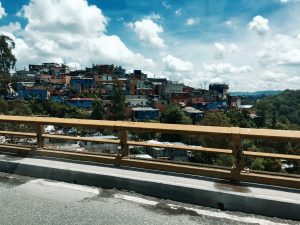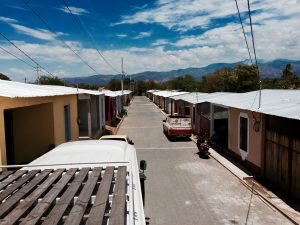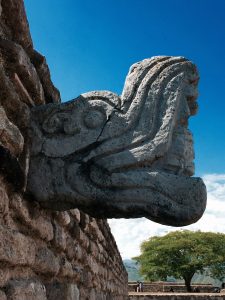
Lost en route to Chocola
We packed up early this morning, halfway into our two weeks in Guatemala. Bags were hoisted onto the bus’ roof rack at 7 AM. A quick breakfast omelet and coffee and we’re off on a 10-hour journey to Chocola via Mixco Viejo, the Mayan pyramids. We swing out of the hotel driveway, the interior of the bus festooned in crepe paper, singing the birthday song to one of our fellow students.
Bumping down the road we are soon passing through Guatemala City for the second time. My senses are on red alert from information overload. Advertisements are seemingly pasted or painted on every vertical surface. Electric infrastructure crisscrosses roads and structures. Diesel and cooking oil fumes intermingle as we stop to re-fuel. The smell of chicken frying floating through the gas station is both hunger-inducing and repulsive. Back on the road, a motorcycle rider disappears in a black cloud as a local bus accelerates from a stop. Close by multi-story residences hang off hillsides facing the highway. Almost always their construction is incomplete and colorful laundry hangs from ropes, spanning rebar to rebar.
Conditions in the Usumatlan Habitat for Humanity communities contrast those in Guatemala City. Small concrete block houses with front porches sit in a neat row fronting streets of concrete paving stones. Houses are nearing completion and families are settling in. Between each home is a narrow yard where some homeowners have installed gates or fences to create garages or private outdoor space. Despite the modest size of the homes residents are very happy to live there. Moist, oppressive heat is mitigated by trees in an older subdivision but not in this new neighborhood. The smell of controlled farmland burns wafts through but the air, intrusive yet cleaner than Guatemala. The urban din is non-existent.
Weaving through the mountain roads leading to Mixto Viejo we see all variations of housing. Dilapidated concoctions of lumber, plastic and corrugated metal appear in random locations. Perched on a hillside, an assembly of huts built from bamboo poles sits above a deeply worn footpath, an example of an old rural solution. In Antigua, the property lines of homes are drawn in blocks of color on the masonry street front. The Habitat neighborhoods in Usumatlan aspire to the look and feel of central Antigua’s narrow cobbled streets, but modern construction does not carry the historical weight of ancestry. In that way it reminds me of new Arizona subdivisions, modern echoes of settlements past, nostalgia bereft of actual history.
This weight of culture and history seems to dominate every place we visit here. In Mixto Viejo it’s easy to envision the ball court filled with spectators cheering on contestants in the deep alleys between stone bleachers. Along the roadside Mayan people dressed in brilliantly colored garb are easy to imagine cheering in the now silent stadium.
We lost our way late this morning on a rural dirt road blocked with a private gate. I can’t help to think of it as a metaphor for development in Guatemala. Growing out of a deep history, Guatemalan people have tried to keep pace with the modern world only to find the path littered, and often blocked, with a confused mix of aspiration and centuries-old beliefs, values and behaviors. With the intrusions of modern technology, people are questioning their happiness and seeking a comfortable balance between new and old. Our anchors to the past slow our voyages into the future in good ways and bad. Universally, we all seek comfort, connection and aspire to a better future, but we are both encumbered and emboldened with what has worked in times past. I wonder if Americans or Guatemalans have lost their way. We cut roads into the pristine unknown, enticing Guatemalans to follow, while undercutting their ability to do so.




